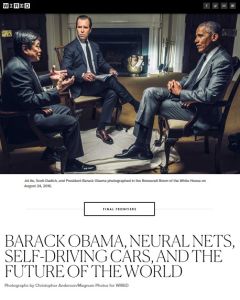Зарегистрируйтесь на getAbstract, чтобы получить доступ к этому краткому изложению.

Зарегистрируйтесь на getAbstract, чтобы получить доступ к этому краткому изложению.
Joi Ito, Scott Dadich and Barack Obama
Barack Obama, Neural Nets, Self-Driving Cars, and the Future of the World
The President in Conversation with MIT’s Joi Ito and Wired’s Scott Dadich
Wired, 2016
Что внутри?
Will machines replace your job? Barack Obama and MIT’s Joi Ito discuss the sociopolitical challenges of AI.
Recommendation
Scott Dadich’s article provides a rare opportunity to learn from the perspectives of two major proponents of artificial intelligence (AI): former US president Barack Obama and accomplished MIT professor and director of the MIT Media Lab, Joi Ito. Written in transcript form, the article captures an honest, practical conversation among the author, Obama and Ito as they examine sociopolitical issues associated with AI and their proposed solutions. getAbstract recommends this analysis to anyone concerned about the intersection of AI with the economy, politics and society.
Summary
About the Authors
Editor in chief of Wired, Scott Dadich authors and edits articles about current events and issues pertaining to science, technology, design and culture.


























Comment on this summary